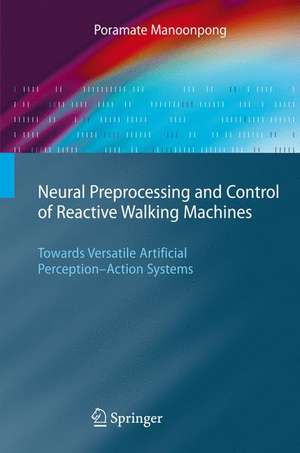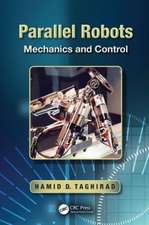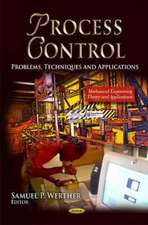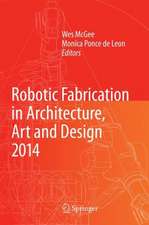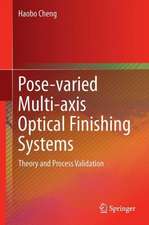Neural Preprocessing and Control of Reactive Walking Machines: Towards Versatile Artificial Perception-Action Systems: Cognitive Technologies
Autor Poramate Manoonpongen Limba Engleză Hardback – 15 mai 2007
| Toate formatele și edițiile | Preț | Express |
|---|---|---|
| Paperback (1) | 382.75 lei 6-8 săpt. | |
| Springer Berlin, Heidelberg – 30 noi 2010 | 382.75 lei 6-8 săpt. | |
| Hardback (1) | 390.63 lei 6-8 săpt. | |
| Springer Berlin, Heidelberg – 15 mai 2007 | 390.63 lei 6-8 săpt. |
Din seria Cognitive Technologies
- 20%
 Preț: 350.99 lei
Preț: 350.99 lei - 15%
 Preț: 649.71 lei
Preț: 649.71 lei - 20%
 Preț: 336.21 lei
Preț: 336.21 lei - 15%
 Preț: 635.47 lei
Preț: 635.47 lei - 20%
 Preț: 650.73 lei
Preț: 650.73 lei - 20%
 Preț: 644.15 lei
Preț: 644.15 lei - 20%
 Preț: 886.16 lei
Preț: 886.16 lei - 20%
 Preț: 331.91 lei
Preț: 331.91 lei - 20%
 Preț: 337.13 lei
Preț: 337.13 lei - 20%
 Preț: 1458.56 lei
Preț: 1458.56 lei - 20%
 Preț: 646.80 lei
Preț: 646.80 lei - 20%
 Preț: 994.08 lei
Preț: 994.08 lei - 20%
 Preț: 649.09 lei
Preț: 649.09 lei -
 Preț: 397.38 lei
Preț: 397.38 lei - 20%
 Preț: 988.00 lei
Preț: 988.00 lei - 20%
 Preț: 1009.61 lei
Preț: 1009.61 lei - 20%
 Preț: 597.18 lei
Preț: 597.18 lei - 20%
 Preț: 614.19 lei
Preț: 614.19 lei - 20%
 Preț: 675.51 lei
Preț: 675.51 lei - 20%
 Preț: 994.40 lei
Preț: 994.40 lei - 20%
 Preț: 891.89 lei
Preț: 891.89 lei - 20%
 Preț: 600.41 lei
Preț: 600.41 lei - 20%
 Preț: 533.76 lei
Preț: 533.76 lei - 20%
 Preț: 647.61 lei
Preț: 647.61 lei - 20%
 Preț: 645.14 lei
Preț: 645.14 lei - 20%
 Preț: 512.39 lei
Preț: 512.39 lei - 20%
 Preț: 338.68 lei
Preț: 338.68 lei - 20%
 Preț: 345.22 lei
Preț: 345.22 lei - 20%
 Preț: 668.55 lei
Preț: 668.55 lei -
 Preț: 365.21 lei
Preț: 365.21 lei - 20%
 Preț: 640.51 lei
Preț: 640.51 lei - 20%
 Preț: 1297.17 lei
Preț: 1297.17 lei
Preț: 390.63 lei
Nou
Puncte Express: 586
Preț estimativ în valută:
74.76€ • 77.76$ • 61.72£
74.76€ • 77.76$ • 61.72£
Carte tipărită la comandă
Livrare economică 14-28 aprilie
Preluare comenzi: 021 569.72.76
Specificații
ISBN-13: 9783540688020
ISBN-10: 3540688021
Pagini: 190
Ilustrații: XVI, 187 p.
Dimensiuni: 155 x 235 x 17 mm
Greutate: 0.48 kg
Ediția:2007
Editura: Springer Berlin, Heidelberg
Colecția Springer
Seria Cognitive Technologies
Locul publicării:Berlin, Heidelberg, Germany
ISBN-10: 3540688021
Pagini: 190
Ilustrații: XVI, 187 p.
Dimensiuni: 155 x 235 x 17 mm
Greutate: 0.48 kg
Ediția:2007
Editura: Springer Berlin, Heidelberg
Colecția Springer
Seria Cognitive Technologies
Locul publicării:Berlin, Heidelberg, Germany
Public țintă
ResearchCuprins
Biologically Inspired Perception-Action Systems.- Neural Concepts and Modeling.- Physical Sensors and Walking Machine Platforms.- Artificial Perception-Action Systems.- Performance of Artificial Perception-Action Systems.- Conclusions.
Textul de pe ultima copertă
This book presents biologically inspired walking machines interacting with their physical environment. It describes how the designs of the morphology and the behavior control of walking machines can benefit from biological studies. The purpose of this book is to develop a modular structure of neural control generating different reactive behaviors of the physical walking machines, to analyze the neural mechanisms underlying the reactive behaviors, and to demonstrate the sensor fusion technique leading to smooth switching between appropriate behaviors, like obstacle avoidance and sound tropism.
The author offers an example of artificial perception-action systems and emphasizes the close relationship between biological studies, computational neuroscience and engineering. The book will be of interest to researchers, engineers and students in the fields of robotics, biologically inspired mechatronics, electronics engineering, control, and artificial intelligence.
The author offers an example of artificial perception-action systems and emphasizes the close relationship between biological studies, computational neuroscience and engineering. The book will be of interest to researchers, engineers and students in the fields of robotics, biologically inspired mechatronics, electronics engineering, control, and artificial intelligence.
Caracteristici
Offers an example of artificial perception-action systems emphasizing the close relationship between biological studies, computational neuroscience and engineering Includes supplementary material: sn.pub/extras
